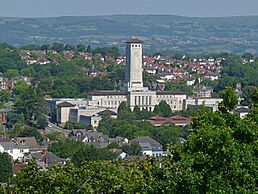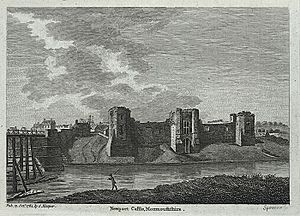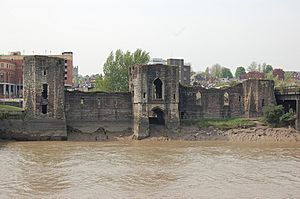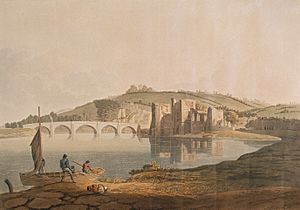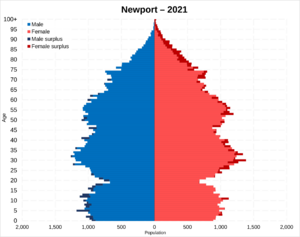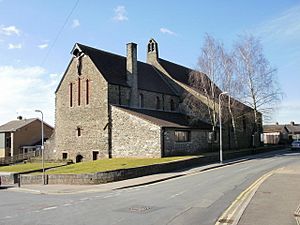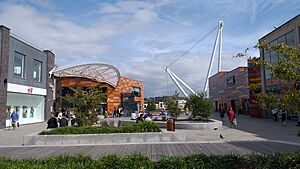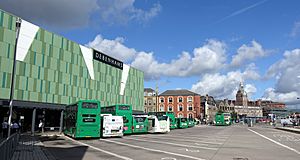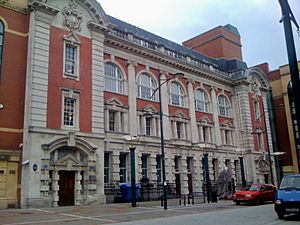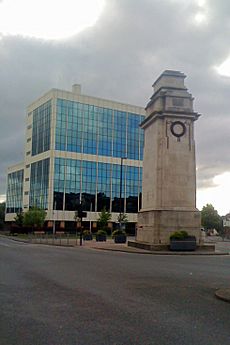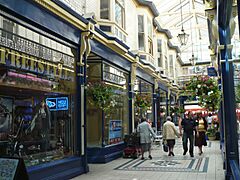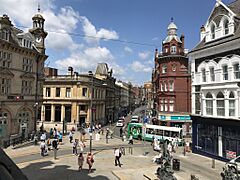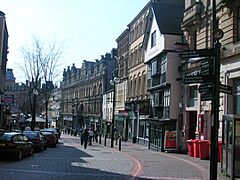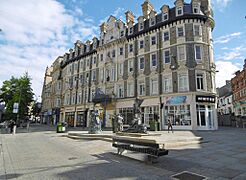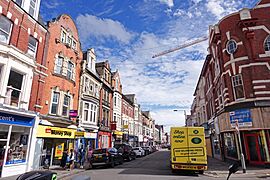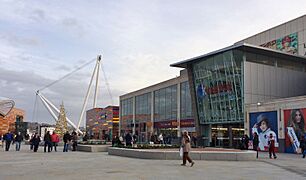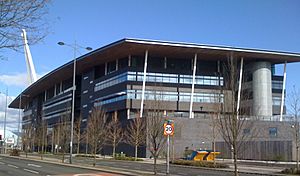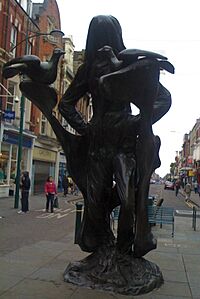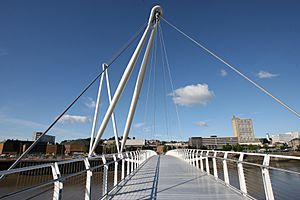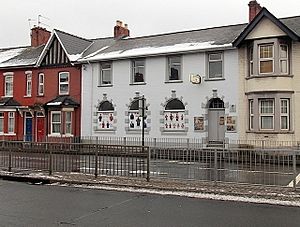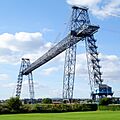Newport, Wales facts for kids
Quick facts for kids
Newport
Casnewydd (Welsh)
|
||
|---|---|---|
|
County borough and city
|
||
|
Clockwise from top: Newport Transporter Bridge, Tredegar House, Newport Cathedral, Newport Civic Centre, Newport Castle, and Celtic Manor Resort
|
||
|
||
| Motto(s): | ||
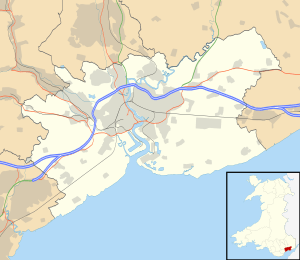
Newport shown within Wales
|
||
| Sovereign state | United Kingdom | |
| Country | Wales | |
| Preserved county | Gwent | |
| Borough status | c. 1120 | |
| Town charter | 1385 | |
| City status | 2002 | |
| Administrative HQ | Newport Civic Centre | |
| Government | ||
| • Type | Principal council | |
| • Body | Newport City Council | |
| Area | ||
| • Total | 70 sq mi (190 km2) | |
| Area rank | 18th | |
| Population
(2022)
|
||
| • Total | 161,506 | |
| • Rank | 6th | |
| • Density | 2,200/sq mi (848/km2) | |
| Demonym(s) | Newportonians | |
| Time zone | UTC+0 (GMT) | |
| • Summer (DST) | UTC+1 (BST) | |
| Postcode areas |
NP
|
|
| Dialling codes | 01633 | |
| ISO 3166 code | GB-NWP | |
| GSS code | W06000022 | |
Newport (Welsh: Casnewydd [kasˈnɛwɨð]) is a lively city and county borough in Wales. It sits on the River Usk, close to where it meets the Severn Estuary. Newport is about 12 miles (19 kilometres) northeast of Cardiff. The city's population grew a lot between 2011 and 2021, reaching 159,587 people. This was the biggest growth for any single authority in Wales. Newport is the third-largest city in Wales and the sixth most populated overall. It became a city in 2002.
Newport has been an important port since the Middle Ages. The first Newport Castle was built by the Normans. The city grew bigger than the older Roman town of Caerleon, which is now part of Newport. Newport got its first official document, called a charter, in 1314. It grew a lot in the 1800s because its port became a key place for shipping coal from the eastern South Wales Valleys. Newport was the biggest coal exporter in Wales until Cardiff grew bigger in the mid-1800s. Newport was also the site of the last big armed uprising in Great Britain, known as the Newport Rising in 1839.
In the 1900s, the docks became less important. However, Newport remained a key place for manufacturing and engineering. More recently, its economy has grown thanks to high-tech companies along the M4 corridor. The Celtic Manor Resort in Newport hosted the Ryder Cup golf tournament in 2010. It also held the 2014 NATO summit. The city includes large rural areas around its main built-up part. Its villages are very important for archaeology. Newport Cathedral is the main church for the Anglican Bishop of Monmouth.
Contents
- What's in a Name?
- Newport's Past: A Journey Through Time
- Newport's Location and Landscape
- Weather in Newport
- Who Lives in Newport?
- Newport's Economy
- Making Newport Better: Regeneration Projects
- Getting Around Newport: Transport
- Famous Buildings and Structures
- Shopping in Newport
- Education in Newport
- Newport's Culture and Arts
- Walking, Cycling, and Sports
- Sports in Newport
- Local News and Media
- Sister Cities
- Freedom of the City
- Images for kids
- See also
What's in a Name?
The original Welsh name for the city was Casnewydd-ar-Wysg. This means 'new castle on the Usk'. This name was used around 1172. "New castle" likely refers to an older fort on Stow Hill. Or it could mean a fort where the current castle stands.
The English name 'Newport' came later. The Normans first recorded the settlement as novo burgus in 1126. This Latin name means 'new borough' or 'new town'. It was set up with the Norman castle. The name Newport likely became popular with traders. It helped them tell the "New port" apart from the "Old Roman port" at Caerleon.
Newport's Past: A Journey Through Time
Early Days of Newport
Long ago, in the Bronze Age, fishermen lived near the River Usk. Later, the Celtic Silures built hillforts overlooking the river. In AD 75, Roman legions built a fort at Caerleon. This fort helped defend the river crossing. Around the late 400s, Saint Gwynllyw (Woolos) founded the church that would become Newport Cathedral. This church was definitely there by the 800s. Today, it is the main church for the Bishop of Monmouth.
In 1049, Vikings from Orkney, led by Welsh king Gruffydd ap Llywelyn, sailed up the Usk. They attacked St Gwynllyw's church. The church was attacked again in 1063 by Harold Godwinson. The Normans arrived around 1088. They built the first Newport Castle and a river crossing. This was downstream from Caerleon. The first Norman Lord of Newport was Robert Fitzhamon.
The first Newport Castle was a small motte-and-bailey castle. It was located opposite Newport Cathedral. Today, no part of it can be seen. It was covered by rubble from railway tunnels dug in the 1840s.
Newport's Growth and Challenges
The new town grew around the castle and became Newport. It received its first official document, a charter, in 1314. Another charter was given in 1385. This one was from Hugh Stafford, 2nd Earl of Stafford. The Newport coat of arms shows the Stafford family's symbols. In the 1300s, Augustinian friars built a hospital for sick people. This hospital's name lives on in "Spytty Fields". "Austin Friars" is also a street name.
During the Last War for Welsh Independence in 1402, Rhys Gethin took Newport Castle. He also took other castles nearby. During this attack, Newport town was badly burned. Saint Woolos church was also destroyed.
A third charter in 1426 allowed the town to run its own market and trade. By 1521, Newport was known for its good harbour. Trade was busy with nearby ports like Bristol. Industries included leather, soap, and starch making. The town had many skilled workers like bakers and blacksmiths. Another charter was given by James I in 1623.
During the English Civil War in 1648, Oliver Cromwell's soldiers camped near Newport. They attacked the castle the next day. A cannonball from that time was found in a garden. It is now in Newport Museum.
The Industrial Age and Big Changes
As the Industrial Revolution changed Britain, the South Wales Valleys became important for coal and iron. These materials were sent down rivers and new canals to ports like Newport. Newport Docks grew very quickly. By 1830, Newport was Wales's main coal port. It was even bigger than Cardiff until the 1850s.
The Newport Rising in 1839 was the last big armed protest in mainland Britain. John Frost and 3,000 other Chartists marched to the Westgate Hotel. They wanted to free Chartists held prisoner there. Some Chartists had weapons. A fight broke out between the Chartists and soldiers. At least 20 Chartists were killed. They were buried in Saint Woolos churchyard. John Frost was sentenced to death but later sent to Australia. John Frost Square in the city centre is named after him.
Newport likely had more Welsh speakers until the 1830s. But many people from England and Ireland moved there. This made the town seem "less Welsh." In the late 1800s, some people even said Newport was part of England.
The late 1800s and early 1900s were a great time for Newport. The Alexandra Docks opened in 1875. The town's population grew fast. It became a county borough in 1891. In 1892, the Alexandra South Dock opened. It was the largest stone dock in the world. Even though coal exports were smaller than Cardiff's, Newport was still very important. The Miners' Federation of Great Britain was founded there in 1889. Many international consuls were based in the town.
In 1898, Lysaght's Orb Works opened. By 1901, it employed 3,000 people. The town grew south, needing a new way to cross the River Usk. The Newport Transporter Bridge was built in 1906. It is called "Newport's greatest treasure."
More parts of the South Dock opened in 1907 and 1914. The Newport Docks Disaster happened on July 2, 1909. During construction, a trench collapsed, burying 46 workers. A 12-year-old paperboy, Thomas 'Toya' Lewis, helped with the rescue. He was very brave and received an award. Memorials to the dead are in St Mark's Church. A pub was named "The Tom Toya Lewis" in his honour.
From 1893, paddle steamers served the town. They were called the "White Funnel Line." These boats sailed from Davis Wharf. By 1955, the steamers stopped coming to Newport.
Newport's economy was varied. It had factories, engineering works, and shops. But the docks started to decline even before the Great Depression. Unemployment reached 34.7% in 1930. This was high but not as bad as mining towns. Despite hard times, the council built new homes for many people in the 1920s and 1930s. In 1930, the Town Dock was filled in.
After World War II, Newport became successful again. Saint Woolos' Church became a full cathedral in 1949. The modern Llanwern steelworks opened in 1962. The Severn Bridge and parts of the M4 motorway were built in the late 1960s. This made Newport very well-connected. Even though jobs at Llanwern steelworks decreased in the 1980s, new public sector jobs appeared. A factory designed by Richard Rogers helped Newport become a hub for technology companies.
In the early 1990s, Newport had a lively music scene. Some even called it "a new Seattle".
Newport became a city in 2002 to celebrate Queen Elizabeth II's Golden Jubilee. In the same year, a very old merchant ship was found. It was uncovered during construction of the Riverfront Arts Centre. This ship is from between 1445 and 1469. It is the only ship of its kind from that time found anywhere in the world.
Important Dates in Newport's History
- c. 1075: Norman wooden motte and bailey castle built on Stow Hill.
- 1314: First town charter granted.
- 1327–1386: Newport Castle built.
- 1385: Second town charter granted.
- 1402: Town taken by Owain Glyndŵr's forces; Saint Woolos Church destroyed.
- 1426: Third town charter granted.
- 1648: Town taken by Oliver Cromwell's forces during the English Civil War.
- 1672: Tredegar House completed.
- 1796: Opening of the Monmouthshire Canal.
- 1839: Chartist Newport Rising at Westgate Hotel, led by John Frost.
- 1842: Newport Town Dock opens.
- 1875: Alexandra Dock opens.
- 1877: Athletic grounds at Rodney Parade opens.
- 1891: Newport becomes a County Borough.
- 1892: Alexandra South Dock opens.
- 1894: Belle Vue Park opens.
- 1898: Lysaght's Orb Works steelworks opens.

- 1901: Royal Gwent Hospital opens on its current site.
- 1906: Newport Transporter Bridge opens on September 12.
- 1909: Newport Docks Disaster occurs.
- 1915: First public automatic telephone exchange in Britain opens in Newport.
- 1949: Saint Woolos Pro-Cathedral becomes a full cathedral.
- 1962: Llanwern steelworks opens.
- 1963: Newport rugby club beats the New Zealand All Blacks.
- 2002: Newport granted city status; Newport Ship discovered.
- 2010: The Ryder Cup golf competition hosted at the Celtic Manor Resort.
- 2014: The 2014 NATO summit takes place at the Celtic Manor Resort.
- 2015: Friars Walk shopping centre opens.
- 2019: The International Convention Centre Wales opens.
- 2019: Railway electrification reaches Newport.
Newport's Location and Landscape
Newport is about 138 mi (222 km) west of London. It is 12 mi (19 km) east of Cardiff. It is the largest urban area in the historic county of Monmouthshire. The City of Newport includes rural areas. It is the sixth most populated single authority in Wales.
The city is mostly flat. However, it has some hilly areas. Wentwood is 1,014 ft (309 m) above sea level. Areas in the south and east are flat and fertile. Some housing and industrial areas were built on reclaimed marshland. Areas near the River Usk, like Caerleon, are also low. The eastern parts of the city have gentle hills. Christchurch offers wide views of the Usk Valley and the Bristol Channel. Ridgeway and Brynglas also have good views. The city's suburbs have grown outwards, making its shape uneven. The urban area is still growing fast with new homes.
The city limits include several villages.
Newport's Areas and Districts
The city is divided into 21 areas called wards. Most of these wards are also communities. Each community can have its own elected council.
Weather in Newport
Newport has a mild temperate climate. The weather usually changes every few days. The city is one of the sunnier places in Wales. Its sheltered location protects it from extreme weather. Newport has mild summers and cool winters.
Thunderstorms can happen any time but are most common in late spring and summer. Rain falls all year. Atlantic storms bring a lot of rain in autumn. Snow falls in most winters and sometimes stays on the ground for a few days. Newport has few days with strong winds compared to other parts of Wales. Frosts are common from October to May.
On March 20, 1930, the temperature dropped to −16.1 °C (3.0 °F). This was the coldest temperature in the UK that year. It was also the latest in spring the UK's lowest temperature had been recorded.
Who Lives in Newport?
| Year | Population |
|---|---|
| 1801 | 6,657 |
| 1851 | 29,238 |
| 1881 | 48,069 |
| 1901 | 79,342 |
| 1941 | 116,434 |
| 1981 | 131,016 |
| 2001 | 137,017 |
| 2022 | 161,506 |
Faiths and Beliefs

In 1929, St Woolos Church became a Pro-Cathedral. It became a full cathedral in 1949. When Rowan Williams became Archbishop of Wales in 2000, Newport Cathedral became the main cathedral of Wales.
Newport was important for Catholicism in Wales. The Diocese of Newport and Menevia was created in 1850. Between 1966 and 1969, Fulton J. Sheen, an American bishop, was named the archbishop of Newport.
The Charles Street Baptist Church was started in 1817. By 1879, services changed from Welsh to English. This was because fewer people spoke Welsh in the town. The church closed in 1993.
In the 2011 census, 56.8% of Newport residents were Christian. 4.7% were Muslim. 1.2% followed other religions. 29.7% said they had no religion. 7.5% did not answer.
Newport has over 50 churches, 7 mosques, and one synagogue. The closest Gurudwara is in Cardiff. The Church in Wales church of St Julius and St Aaron was built in 1926.
Different Backgrounds
In the 2011 census, 89.9% of people described themselves as White. 5.5% were Asian. 1.7% were Black. 1.1% were Mixed White/Black. 0.5% were Mixed White/Asian. 1.4% were from other ethnic groups. In the 2021 census, the percentage of White people decreased to 85.6%. Other groups increased, except for Black Caribbeans.
Newport's Economy
Newport's work area includes much of south Monmouthshire. The city has three main areas for jobs. These are the city centre and business parks near the M4 motorway junctions.
Many important organizations are based in Newport. These include Airbus Defence and Space and the main office of the Office for National Statistics. The UK Intellectual Property Office is also here. Lloyds Banking Group has a large insurance division. There is a big Panasonic factory and a plant for International Rectifier. The headquarters of Gocompare and Wales and West Utilities are in Newport. The Passport Office for much of the UK's south and west is also located here. In 2014, Admiral Insurance opened a large new office.
In 1997, LG Group started a huge project in Newport. It was meant to create 6,100 jobs. However, the semiconductor plant never opened. The CRT plant closed in 2003. In 2005, Quinn Group bought the old LG Phillips building. It became their European base.
Industry in east Newport used to be at the Corus Llanwern steelworks. Steel making stopped in 2001. Plans have been approved to turn the 600-acre (240 ha) former steelworks site into a large new area. It will have homes, offices, shops, and community facilities.
At the mouth of the River Usk, the Sims Metal Management plant has the world's largest industrial shredder for scrap metal. It can be reached by road, rail, and sea. This plant is also the world's largest car crusher.
Newport Cattle Market closed in 2009. It was replaced by a new supermarket. On February 17, 2024, workers from Llanwern steelworks protested in the city centre. They were against job losses at Port Talbot.
Making Newport Better: Regeneration Projects
Newport has seen many big projects to improve the city.
Better Roads and Transport
The first step was to improve the city centre roads. Kingsway and Queensway became wide boulevards. The Southern Distributor Road opened in 2004. It includes the new City Bridge over the River Usk. This made it easier to get around. The Newport City footbridge opened in 2006 for walkers and cyclists.
Newport railway station was made bigger in 2007. It can now handle long trains. In 2010, a new station building was finished. It uses a modern, green structure. This is similar to the Eden Project. In 2019, railway electrification was completed. This cut travel time to London to 1 hour 30 minutes.
Newport bus station was rebuilt in 2013 and expanded in 2015. It now has 24 stands. Local railway stations are reopening. Rogerstone station opened in 2008. Pye Corner station opened in 2014. More are planned.
The Royal Gwent Hospital became a minor injuries unit in 2020. This was after the new Grange University Hospital opened.
A new M4 relief road was planned to ease traffic. This plan was cancelled in 2009 but restarted in 2014. However, it was finally cancelled again in 2019.
Fun and Leisure

The Riverfront Arts Centre was the first new building for Newport's regeneration. It opened in 2004. It is on the west bank of the River Usk. On the east bank, Rodney Parade is home to the Dragons rugby team and Newport County AFC football team.
New Homes and Shops
Newport saw the fastest growth in property values in the UK in 2018.
The city centre is expanding to the east bank of the River Usk. This area will have homes and businesses. It will be connected by the new footbridge. The plan is to have tall, landmark buildings along the river.
The Newport Student Village is next to the university campus. The "Newhaus" development has 154 riverside apartments. The "Alexandra Gate" development has 300 homes near the City Bridge.
In east Newport, land from the former Corus steelworks is being redeveloped. It will have 4,000 houses, shops, and other facilities.

The Friars Walk shopping complex opened in November 2015. It has 30 new shops, about 12 restaurants, and an eight-screen cinema. Plans for the smaller Cambrian Centre were approved in 2012.
The International Conference Centre Wales (ICC Wales) opened in 2019. It is a large conference venue for businesses. It has hosted big events like the UK Space Conference.
The 15-storey Chartist Tower is being turned into a 163-bedroom hotel. It will also have office and retail space. This hotel will help meet the demand for rooms created by the ICC Wales. It opened in May 2022.
Newport Market is also being redeveloped. It will be a mixed-use site with a tech hub, apartments, market stalls, and a food court.
Getting Around Newport: Transport
Newport is the first major city you reach when traveling west from England into Wales. Because of this, it is a key point for national road, bus, and rail routes.
Flying In
The closest airport with regular flights is Cardiff Airport. It is about 30 miles (50 kilometres) southwest of Newport. It takes about 35 minutes to drive there. Or you can take a train journey of about 55 minutes, changing at Cardiff Central.
Bus Travel
Newport bus station is the biggest bus hub in the county. It has 24 stands. It opened in December 2015.
Bus services are mainly run by Newport Bus and Cardiff Bus. Other companies also operate routes. Long-distance National Express and Megabus (Europe) services also stop in Newport.
Train Travel
Newport is the easternmost Welsh city on the UK rail network. It is close to major cities like Cardiff and Bristol. Newport railway station is the third-busiest station in Wales. It is a major transfer station.
The Great Western Main Line connects Newport to Bristol Temple Meads and London Paddington. The Welsh Marches line connects to Holyhead and Manchester Piccadilly. The Gloucester line connects to areas like Cheltenham. The station has four platforms. All express services to and from London Paddington stop here.
Newport is well connected to Cardiff. There are about six train and five bus services every hour. Services to Bristol stop 2-3 times per hour. There are nearly 4 services to London each hour.
Modernizing the Railway
The current Newport station was built in 2010. It has a modern, green design. This was part of a £22 million upgrade. The new station has two terminals, four platforms, and a public footbridge.
New overhead lines have been installed for electrification. This allows faster, all-electric trains to run. Journey times between Newport and London are now around 1 hour 30 minutes.
Rogerstone railway station reopened in 2008. Pye Corner opened around 2015. Direct services between Ebbw Vale and Newport were reintroduced in early 2024.
Train Services from Newport
- Great Western Railway connects to London Paddington, Bristol, Cardiff, and Swansea.
- Transport for Wales connects to Manchester, Holyhead, and Cheltenham.
- CrossCountry connects to Birmingham and Nottingham.
Road Network
M4 Motorway Access
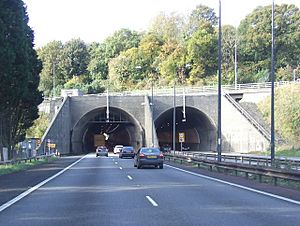
The M4 motorway has several junctions in and near Newport:
- 23A: Local access via A4810 and B4245.
- 24: Coldra A449/A48/B4237.
- 25: Caerleon Road B4596.
- 25A: Grove Park A4042.
- 26: Malpas Road A4051.
- 27: High Cross, B4591.
- 28: Tredegar Park A48/A4072.
- 29: St Mellons A48(M) – no local access.
The Brynglas Tunnels often cause traffic delays. The M4 narrows to two lanes here.
Southern Distributor Road
The Southern Distributor Road (SDR) is part of the A48 road. It runs from M4 Junction 24 in the east to Junction 28 in the west. With the M4, the SDR forms a ring road around the city.
Other Main Roads
- The A48 westbound is an alternative route to Cardiff.
- The A48 eastbound is an alternative route to Chepstow and South West England.
- The A467 connects Newport to Risca and Ebbw Vale.
- The A4810 connects the SDR to the M4.
- The A449 connects Newport to Usk and Gloucester.
- The A4042 connects Newport to Cwmbran and Pontypool.
- The A4051 connects Newport to Cwmbran.
City Centre Roads
The Old Green Interchange is a roundabout over the A4042. Newport's High Street runs from here to Commercial Street. Queensway passes Newport railway station. Kingsway/Usk Way is a wide road along the west bank of the River Usk.
Corporation Road follows the east bank of the River Usk. It connects Newport Bridge to other bridges.
Famous Buildings and Structures
Many of Newport's famous places are in or near the Newport city centre. These include:
- Newport Cathedral (c. 400–500)
- Newport Castle (c. 1075)
- Newport Bridge (1800)
- Ye Olde Murenger House (1819)
- Newport railway station (rebuilt 2010)
- Newport Market (1854)
- Rodney Parade (1875)
- Westgate Hotel (1881)
- Belle Vue Park (1891)
- Royal Gwent Hospital (1901)
- Transporter Bridge (1906)
- Civic Centre (1939)
- George Street Bridge (1964)
- Riverfront Arts Centre (2004)
- Newport City footbridge (2006)
- University of South Wales, Newport Campus (2011)
The city has many beautiful churches.
Other landmarks include:
- West Usk Lighthouse – now a hotel.
- Beechwood House – in Beechwood Park.
- Isca Augusta – Roman fort remains in Caerleon, with baths and an amphitheatre.
- Newport Cenotaph – a war memorial.
- Main Post Office – an old building with a blue plaque.
- Newport Arcade – a Victorian shopping arcade.
- Tredegar House – a 17th-century mansion, once home to the Morgan family. It is now owned by the council.
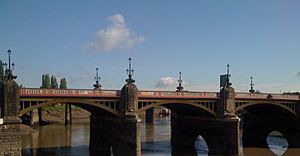

Newport has nine public bridges over the River Usk. They connect the east and west sides of the city. From north to south, they are: Caerleon Bridge, St. Julian's railway bridge, M4 motorway Usk bridge, Usk Railway Bridge, Newport Bridge, Newport City footbridge, George Street Bridge, City Bridge and Transporter Bridge.
The city has a long history of bridges. Wooden bridges date back to Norman times. Stone ones started in 1800.
Shopping in Newport
City Centre Shopping
The main shopping streets in Newport city centre are for pedestrians only. These include High Street and Commercial Street. Other nearby roads also have shops.
The five roads of Commercial Street, Stow Hill, Bridge Street, High Street, and Skinner Street meet at Westgate Square. This is seen as the city's central point.
Kingsway Shopping Centre is an indoor shopping mall. The nearby Friars Walk shopping centre opened in November 2015. It has 30 shops, about 12 restaurants, and an 8-screen cinema. Newport Market is a Victorian indoor market. It has two floors with stalls selling food and other products.
Retail Parks
Outside the city centre, there are large retail parks. They are located off the Southern Distributor Road:
- Newport Retail Park is in the east at Lliswerry.
- Three retail parks (Harlech, Maesglas, and 28 East) are in the west at Maesglas.
Education in Newport
The University of South Wales campus is in Newport city centre. It is on the west bank of the River Usk. The university started as the Newport Mechanics Institute in 1841. Newport School of Art, Media and Design was one of the first art schools to offer degrees in 1973. It was well-known for painting and fine art.
Newport also has Coleg Gwent City of Newport Campus, known as Nash College. Brynglas House is an Adult Education Centre.
Newport has eight English-speaking state comprehensive schools. It also has three Welsh-medium primary schools. The Welsh-medium secondary school is Ysgol Gyfun Gwent Is Coed. All these schools are managed by Newport Local Education Authority. There is also one private school, Rougemont School.
A football academy is based at Llanwern High School. It started in 1998. Students in the academy train and study for sports qualifications.
Newport's Culture and Arts
The Newport Transporter Bridge is one of the few working bridges of its kind. You can ride on the suspended platform most days. You can also walk on top of the steel frame on bank holidays.
The Riverfront Arts Centre is a modern theatre and arts venue. The Dolman Theatre was updated in 2005. The Phyllis Maud Performance Space is a small theatre in a converted public toilet.
The city has many public artworks:
- A 40 ft-high (12 m) steel Wave sculpture by Peter Fink (1991).
- Twelve painted murals by Hans Feibusch (1961–64) at the Newport Civic Centre.
- Tiled murals by Kenneth Budd (1975).
- Statues called Union, Prudence, Energy by Christopher Kelly (1991). They remember the Chartist Newport Rising.
- The Stand and Stare statue by Paul Bothwell Kincaid. It honors poet W. H. Davies, who was born in Newport.
- A statue of Charles Morgan, 1st Baron Tredegar, by John Evan Thomas (1850).
- The Merchant Navy Memorial statue by Sebastien Boyesen (1991).
- This Little Piggy statue by Sebastien Boyesen (1994) outside Newport Market.
- The Vision of St.Gwynllyw/The Bell Carrier statue by Sebastien Boyesen (1996).
- Archform sculpture by Harvey Hood at Newport Railway Station.
- In the Nick of Time, also known as the Newport Clock, by Andy Plant.
- A drinking fountain (1913) made by Royal Doulton at Newport Cathedral.
- A stone memorial to the Allied invasion of Europe in High Street.
- A Chartist Frieze by Sebastien Boyesen (2015) in Friars Walk.

Newport has three main museums: Newport Museum in the city centre. In Caerleon, there is the National Roman Legion Museum and Roman Baths Museum. Newport Central Library is inside Newport Museum. Every July, Caerleon hosts an Arts festival. It also has a Roman Military re-enactment. The remains of the Roman fort Isca Augusta can be seen in Caerleon.
The Newport Festival takes place during the summer. Many events are held in the city centre.
Tredegar House is a 17th-century mansion. It is set in a 90 acres (36 hectares) park. It was home to the Morgan family for over 500 years. The council bought it in 1974.
Newport hosted the National Eisteddfod of Wales in 1897, 1988, and 2004.
A large mosaic Chartist Mural was created in 1978. It remembered the Chartist rising of 1839. It was removed in 2013 for city redevelopment. A smaller replica was unveiled in 2019. It was made by Oliver Budd, son of the original artist.
In 2010, French circus star Olivier Roustan performed a high wirewalk. He walked along the top cable of the Newport City footbridge.
Newport hosted an outdoor art show called "SuperDragons" in 2010. It showed 60 large dragons decorated by local groups.
Music and Nightlife
The city centre has many pubs, bars, and nightclubs. Most are near High Street. TJ's, a famous alternative music club, closed in 2010.
The Riverfront Arts Centre is a popular concert venue. Other live music venues include NEON and Le Pub. The Newport Centre used to host many concerts. It closed during the COVID-19 pandemic and was demolished in 2023. The new leisure centre will not have a concert space.
Outdoor music events are held in summer at Beechwood Park and Belle Vue Park.
Newport is the subject of a 2010 song, "Newport (Ymerodraeth State of Mind)". It was a parody of an Alicia Keys song. The video became very popular online.
The City of Newport Male Choir is a leading male voice choir.
Parks and Green Spaces
Newport's main public parks are Tredegar Park, Belle Vue Park, and Beechwood Park. The main public playing fields are at Tredegar Park, Coronation Park, and others.
To the south, you can find the Newport Wetlands Reserve. This reserve opened in 2000. It was created to make up for lost mudflats. A Local Nature Reserve is also at Allt-yr-yn.
Walking, Cycling, and Sports
The Newport City footbridge is for cyclists and walkers. It links the east and west banks of the River Usk. A path along the River Usk links Newport city centre to Caerleon. You can walk or cycle from the north to the south of the city.
The Celtic Trail cycle route and National Cycle Route 4 pass through Newport.
The main public sports facilities are at Newport Centre and Newport International Sports Village. There is an indoor bowls arena.
The city has a busy Scout District.
Sports in Newport
Boxing
The boxer David Pearce was born in Newport.
Rugby
Newport RFC started in 1874. It was one of the first members of the Welsh Rugby Union. Newport was the only team to beat the undefeated All Blacks in 1963–64. They have also beaten Australia and South Africa.
Since 2003, Newport RFC plays in the Welsh Premier Division. They are a feeder club for the Dragons regional team. The Dragons play at Rodney Parade. Newport RFC plays most home games at Newport Stadium.
Nine other rugby union teams in the Welsh League are based in Newport.
Newport also had a rugby league club called the Newport Titans. It stopped playing in 2012.
Football
Newport's most famous association football club is Newport County. They started in 1912 and joined the English Football League in 1920. They have played in the second tier of English football. They reached the last 16 of the FA Cup. They won the Welsh Cup in 1980. They reached the quarter-finals of the European Cup Winners' Cup in 1981. They were relegated in 1988 and went bankrupt the next year. The club reformed in 1989. They returned to the Football League for the 2013–14 season. They now play in Football League Two.
Newport is also home to other football clubs. Dragon Park, the Football Association of Wales' National Football Centre, is in Newport.
Golf
The city has the Celtic Manor Resort. It is a five-star resort and hosts the Wales Open golf tournament. The resort hosted the All*Star Cup in 2005 and the 2010 Ryder Cup.
Newport has great golf courses. These include Llanwern Golf Club and Newport Golf Club. Caerleon has a good nine-hole course.
Cycling
The Newport International Sports Village has the Wales National Velodrome. This is the main office for Welsh Cycling.
Tennis
Newport was an important place for British Tennis. The 1906 International Lawn Tennis Challenge (now the Davis Cup) was held at Newport Athletic Club.
Other Sports
Newport Cricket Club has been at the Newport International Sports Village since 1990.
For many years, the city had a motorcycle speedway team, Newport Wasps. The team stopped in 2012.
Newport is one of three main cities where British baseball is still played. The city hosts an international match every four years.
The South East Wales Regional Swimming Pool is at the Newport International Sports Village. Newport Tennis Centre is also there. It is a multi-sport facility.
St. Joseph's Amateur Boxing Club is on George Street. It is the home club of famous boxers like Mo Nasir and Sean McGoldrick.
Treetops Shooting Ground is one of Britain's best clay pigeon shooting grounds.
Newport hosted the International Cross Country Championships six times.
Newport has a Skittle Alley League with over 50 teams.
Horse racing was held at Newport Racecourse until 1948.
Yearly Sports Events
Newport hosts several yearly sports events:
- The Wales Open golf tournament.
- The Elemis Invitational Trophy tennis tournament.
- The Welsh Open world ranking snooker tournament.
- The World Cup of Pool.
- The Newport Half Marathon.
Local News and Media
Newport's local newspaper is the South Wales Argus. It is published in the city. There is also a daily Newport edition of the Western Mail. NewportOnline is the city's most-read online news platform.
Local TV news programs are BBC Wales Today and ITV Wales at Six.
Local radio stations include Capital South Wales and Smooth Wales. Newport also has several internet radio stations. The most popular is Newport City Radio.
Sister Cities
Newport is twinned with:
- Heidenheim, Germany (since 1980)
- Kutaisi, Georgia (since 1989)
Past Connections
Newport used to have a connection with Guangxi Province, China, from 1996 to 2019. Newport City Council ended this relationship in 2019. This was due to concerns about the Yulin Dog Meat Festival. Many people asked the council to end the agreement. The council decided to cut ties after their letters to Guangxi officials were ignored.
Freedom of the City
The following people, military units, and groups have received the Freedom of the City of Newport.
People Honored
- Godfrey Morgan, 1st Viscount Tredegar: 1909.
- James Henry Thomas: 1924.
- Field Marshal Lord Montgomery of Alamein: 1945.
- Sir Harry Jones: 2004.
Military Units Honored
- The South Wales Borderers: 1947.
- The Royal Regiment of Wales: 1969.
- 104th Regiment Royal Artillery: 1978.
- The Royal Welch Fusiliers: 2001.
- The Merchant Navy Association: 2002.
- HMS Severn, RN: 2006.
Organizations Honored
- Newport County Association Football Club: 2013.
- Newport Rugby Football Club: 2013.
- The Royal British Legion: 2021.
Images for kids
See also
 In Spanish: Newport para niños
In Spanish: Newport para niños







